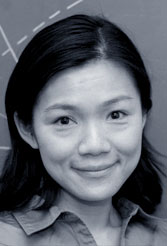

A: I am a particle theorist. I build models to explain how neutrinos – one of the fundamental particles that make up the universe – morph from one type to another while traveling in space. My collaborators and I proposed a model that yields neutrino mass, while at the same time predicting the existence of a new particle called the Z' gauge boson. The Z' gauge boson may be discovered in the early stages of the LHC.
A: I hope the LHC will unveil the origin of mass generation for all elementary particles. I also hope we will learn how neutrinos interact. Knowledge about neutrino properties could shed light on the source of their tiny masses and the mechanism that causes their morphing.
A: The neutrino is the most abundant, yet elusive particle in the universe. In each cubic foot of space, 10 million neutrinos from the Big Bang exist, and each second, 100 trillion neutrinos from the sun pass through each of us. Without the neutrino, the sun would not shine and we would not exist. So to understand the universe and why we exist, clearly we need to learn about the properties of neutrinos.
A: I am interested in particle physics because it involves the interactions of all matter at the most fundamental level. The most fascinating aspect to me is that all of the interactions can be consequences of certain mathematical structures called “gauge symmetries.” Once we know the gauge symmetries, all interactions can be calculated, and the effects of these interactions can then be tested by experiments such as the LHC.